Accepted Scientific Name: Ferocactus emoryi subs. rectispinus (Engelm.) N.P.Taylor
Cactaceae Consensus Init. 6: 16. 1998
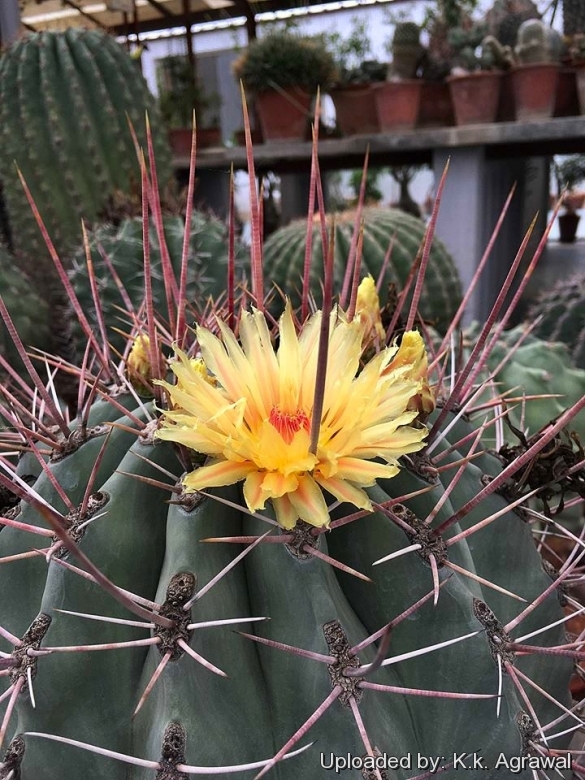
Ferocactus rectispinus (Ferocactus emoryi subs. rectispinus) Photo by: K.k. Agrawal
Origin and Habitat: (Central Baja California, Mexico) Ferocactus rectispinusSN|21500]]SN|21500]] is a narrow endemic species, usually found near the coast in the vicinity of Bahía de la Concepción. The Cerro Colorado population is more inland and farther north than any previously documented.
Habitat: Often on costal high cliffs.
Synonyms:
See all synonyms of Ferocactus emoryi
Common Names include:
ENGLISH: Straight Spine Barrel, Long Spined Barrel Cactus
Description: Ferocactus rectispinusSN|21500]]SN|21500]] is a solitary barrel cactus except in case of injury to the growing tip.
Stems: Erect, globular when young to a stout cylinder when older, 30-200 tall, 30-60 cm across; tubercled when young later forming ribs.
Ribs: 15-21, shallowly notched immediately above each areole.
Areoles: Oval with brown wool, 3-4 cm apart.
Central spine: 1, very long ( 9-25 cm long × 2.5-4 mm. in cross section ), never hooked (or slightly hooked, but only on relatively young plants), roughly cylindrical, annulate, all robust and rigid. Reddish, reddish grey, or horn coloured.
Radial spines: 5 to 9, spreading, not hooked, 2.5 to 7 cm long, with the upper 3 larger.
Flowers: Large, light yellow, 6-7.5 long, 5-7.5 cm in diameter.
Blooming season:* Summer.
Fruits: Persistent, oblong, scaled, 2,5-5cm long × 25-35 mm long in diameter with the dried remains of the flower atop, ± readily dehiscent through basal pore, bright yellow.
Seeds: 2 mm in diameter, black.
Subspecies, varieties, forms and cultivars of plants belonging to the Ferocactus emoryi group
Bibliography: Major references and forther lectures
1) Edward Anderson “The Cactus family” Timber Press, Incorporated, 2001
2) James Cullen, Sabina G. Knees, H. Suzanne Cubey "The European Garden Flora Flowering Plants: A Manual for the Identification of Plants Cultivated in Europe, Both Out-of-Doors and Under Glass" Cambridge University Press, 11/Aug/2011
3) David R Hunt; Nigel P Taylor; Graham Charles; International Cactaceae Systematics Group. "The New Cactus Lexicon" dh books, 2006
4) N. L. Britton, J. N. Rose “The Cactaceae. Descriptions and Illustrations of Plants of the Cactus Family.” Volume 4, The Carnegie Institution of Washington, Washington 1923
5) Curt Backeberg: “Die Cactaceae: Handbuch der Kakteenkunde” Volume V, Gustav Fischer Verlag, Stuttgart New York 1982–1985
6) Sara Oldfield “Cactus and succulent plants: status survey and conservation action plan” IUCN, 1997
7) Clive Innes, Charles Glass “Cacti” Portland House, 01/May/1991
8) Burquez Montijo, A. 2013. Ferocactus emoryi. The IUCN Red List of Threatened Species. Version 2014.2. <www.iucnredlist.org>. Downloaded on 11 November 2014.
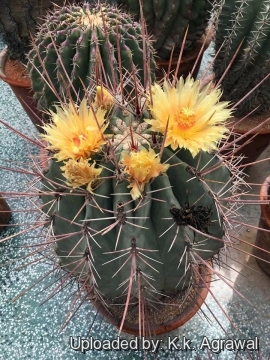 Ferocactus rectispinus (Ferocactus emoryi subs. rectispinus) Photo by: K.k. Agrawal
Ferocactus rectispinus (Ferocactus emoryi subs. rectispinus) Photo by: K.k. Agrawal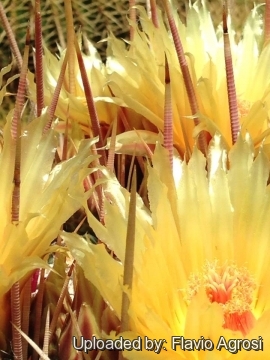 Ferocactus rectispinus (Ferocactus emoryi subs. rectispinus) Photo by: Flavio Agrosi
Ferocactus rectispinus (Ferocactus emoryi subs. rectispinus) Photo by: Flavio Agrosi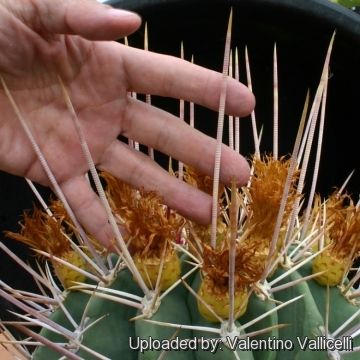 Ferocactus rectispinus (Ferocactus emoryi subs. rectispinus) Photo by: Valentino Vallicelli
Ferocactus rectispinus (Ferocactus emoryi subs. rectispinus) Photo by: Valentino Vallicelli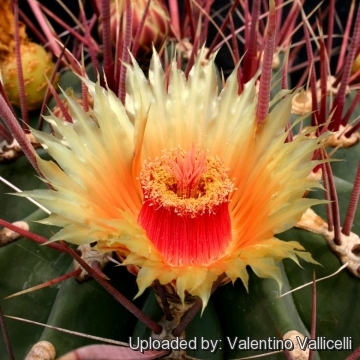 Ferocactus rectispinus (Ferocactus emoryi subs. rectispinus) Photo by: Valentino Vallicelli
Ferocactus rectispinus (Ferocactus emoryi subs. rectispinus) Photo by: Valentino Vallicelli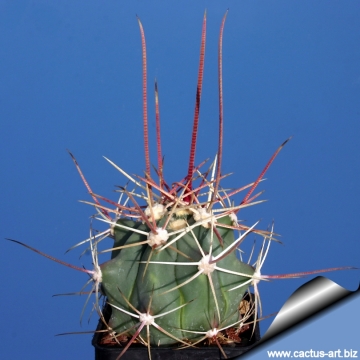 Ferocactus rectispinus (Ferocactus emoryi subs. rectispinus) Photo by: Cactus Art
Ferocactus rectispinus (Ferocactus emoryi subs. rectispinus) Photo by: Cactus Art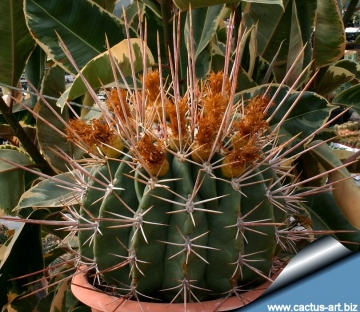 Ferocactus rectispinus (Ferocactus emoryi subs. rectispinus) Photo by: Cactus Art
Ferocactus rectispinus (Ferocactus emoryi subs. rectispinus) Photo by: Cactus Art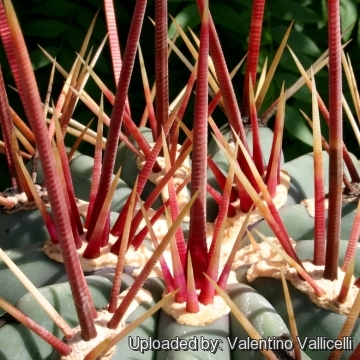 Ferocactus rectispinus (Ferocactus emoryi subs. rectispinus) Photo by: Valentino Vallicelli
Ferocactus rectispinus (Ferocactus emoryi subs. rectispinus) Photo by: Valentino Vallicelli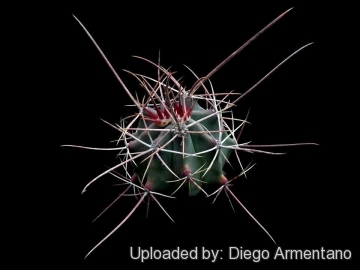 Ferocactus rectispinus (Ferocactus emoryi subs. rectispinus) Photo by: Diego Armentano
Ferocactus rectispinus (Ferocactus emoryi subs. rectispinus) Photo by: Diego ArmentanoCultivation and Propagation: It produce nectar in the nectaries at the top of the cactus that feed the ants that live around its base. In turn, the ants are very territorial and seem to protect the plants from other insects that might try to walk up the stem and damage the fresh, delicate cells at the growing apex or steal nectar or pollen from the flowers. This strategy is useful to not only to protect the plant from small herbivores but also to promote outcrossing pollination because the only bugs that can successfully visit the flowers without being attacked by the ants are flying pollinator insects like butterflies and bees that carry pollen from other individuals and other populations, in turn increasing the genetic diversity of the species.
Cultivation: Slow growing to start but does well under cultivation. Use very draining soil, water during the aestival growth cycle (this plant need plenty of water) But needs to be avoided wetting the bodies of these plants while they are in sunlight. A wet cactus in the sun light can cause sun burning which can lead to scars or even fungal infections and death.
Needs full sun. Keep dry at 10°C in winter, but can tolerate sporadic light frost.
Propagation: Seeds are the only way of reproducing.
Your Photos
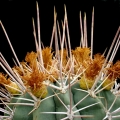
by Valentino Vallicelli
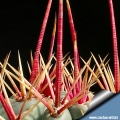
by Cactus Art
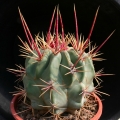
by Valentino Vallicelli

by Cactus Art






















